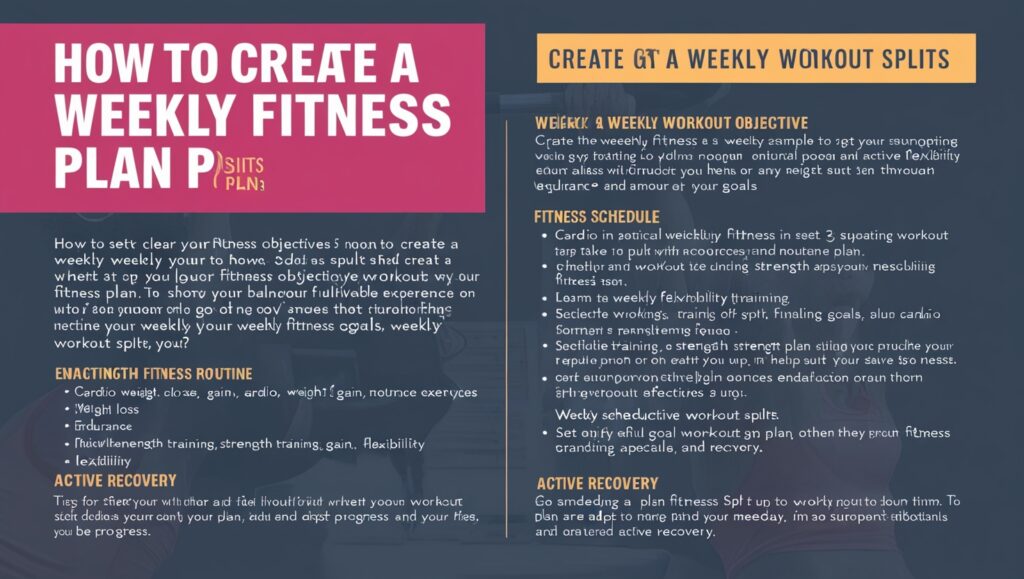How to Create a Weekly Fitness Plan That Works for You
A fitness plan that works for you is one that not only fits your lifestyle but also keeps you motivated and helps you achieve your goals. Whether you’re aiming for weight loss, muscle gain, better health, or stress relief, a well-structured weekly fitness plan can be the key to success. However, creating the right plan can seem daunting with so many workout styles, programs, and advice out there. Here’s a detailed guide on how to create a weekly fitness plan tailored to your needs, preferences, and goals.
1. Set Clear Fitness Goals
Before creating your weekly fitness plan, it’s essential to define your fitness goals. Your plan should be structured around what you want to achieve, whether it’s increasing strength, losing weight, improving endurance, or building flexibility.
Types of fitness goals include:
- Weight Loss: If your goal is to shed pounds, focus on exercises that promote fat burning, such as cardio and strength training.
- Muscle Gain: If you’re looking to build muscle, incorporate strength training with progressively heavier weights.
- Endurance: For improved cardiovascular health or stamina, aim to include more aerobic activities such as running, cycling, or swimming.
- Flexibility and Mobility: If your goal is to become more flexible or enhance your range of motion, include yoga or stretching routines in your plan.
Having clear goals will guide your workout selection and help you measure progress.
2. Choose a Balanced Mix of Exercises
A successful fitness plan should include a variety of exercises to target different areas of fitness and avoid burnout. Incorporating a balanced routine can help prevent overuse injuries and keep things exciting.
Key components to include:
- Cardiovascular Exercise (3-4 times a week): Cardio exercises like running, cycling, or swimming improve heart health, burn fat, and boost endurance. Aim for at least 30 minutes per session, focusing on moderate to intense workouts to maximize results.
- Strength Training (2-3 times a week): Strength training helps you build muscle, increase metabolism, and improve overall body composition. Include exercises like squats, deadlifts, push-ups, and lunges. Focus on different muscle groups each day to allow for recovery.
- Flexibility and Mobility (2-3 times a week): Yoga, Pilates, or simple stretching routines can help you improve flexibility, reduce muscle tightness, and enhance posture. These exercises also promote relaxation and stress relief.
- Active Recovery (1-2 times a week): Rest days are crucial for muscle recovery. Active recovery includes light activities like walking, stretching, or gentle yoga to allow your body to recover while keeping you moving.
3. Plan Your Week Around Your Lifestyle
When crafting your fitness plan, consider your lifestyle and the time you can realistically commit to exercise. The best fitness plan is one that you can stick to in the long run, so it’s important to be honest about how much time you have available.
Time considerations:
- Busy Schedule: If you have a packed calendar, consider shorter, high-intensity interval training (HIIT) sessions that give you an effective workout in 20-30 minutes. Alternatively, you can break up your workout into two shorter sessions throughout the day.
- Available Equipment: If you’re working out at home, focus on bodyweight exercises or invest in minimal equipment like dumbbells, resistance bands, or a kettlebell. If you have access to a gym, make use of machines and free weights to vary your routine.
- Workout Location: Choose a workout space that’s convenient, whether it’s your living room, a gym, or an outdoor park. The more accessible your fitness plan is, the more likely you are to stick to it.
4. Create a Weekly Schedule
Consistency is key to making progress. A weekly schedule helps you stay on track and ensures that you’re hitting all areas of fitness throughout the week. Here’s an example of how to structure your weekly fitness plan:
- Monday: Full-body strength training (strength focus)
- Tuesday: 30-45 minutes of moderate-intensity cardio (running, cycling)
- Wednesday: Yoga or Pilates for flexibility and mobility
- Thursday: Lower body strength training (legs and glutes focus)
- Friday: 30 minutes of HIIT cardio (sprints, circuit training)
- Saturday: Upper body strength training (arms, chest, and back focus)
- Sunday: Active recovery (light walking or stretching)
You can adjust the days and types of workouts according to your preferences, but the key is to make your schedule realistic and sustainable.
5. Progress Gradually and Set Milestones
It’s important not to overwhelm yourself with too much too soon. Gradually increase the intensity of your workouts to avoid burnout and injury. Start with achievable goals and add more challenging elements as you progress.
Tips for progression:
- Increase weights: In strength training, progressively increase the weight you lift as your strength improves.
- Add intervals: In cardio workouts, include sprints or high-intensity intervals to boost fat burning.
- Track performance: Keep a fitness journal or use a fitness app to track your progress. Celebrate small victories like lifting heavier weights, running longer distances, or feeling more energized.
6. Listen to Your Body and Rest When Needed
A key part of any fitness plan is listening to your body. Rest is just as important as exercise because it allows your muscles to recover and grow stronger. If you feel fatigued or experience pain, take an extra rest day or opt for low-impact exercises like swimming or walking.
Signs you may need rest:
- Persistent soreness that doesn’t go away
- Feeling overly fatigued or drained during workouts
- Pain or discomfort during exercise
- Lack of motivation or enthusiasm for workouts
Rest is essential to avoid overtraining and reduce the risk of injury.
7. Fuel Your Body Properly
Exercise is only one part of the fitness equation. Nutrition plays a significant role in your performance and recovery. Make sure to eat a balanced diet that supports your activity level.
Nutritional tips:
- Protein: Consume adequate protein to repair muscles after strength training. Include lean meats, fish, eggs, or plant-based sources like beans and lentils.
- Carbohydrates: Fuel your body with healthy carbs for energy, especially before cardio workouts. Whole grains, fruits, and vegetables are great sources.
- Hydration: Drink plenty of water throughout the day to stay hydrated and support optimal performance during workouts.
8. Track Your Progress and Adjust as Needed
Your fitness journey is unique, and your plan should evolve with your progress. Track your results regularly, whether through fitness apps, progress photos, or measurements, and adjust your plan accordingly. If you reach a plateau or stop seeing progress, it might be time to tweak your routine—whether that means changing up your workouts or pushing yourself harder.
Final Thoughts
Creating a weekly fitness plan that works for you involves setting clear goals, balancing different types of exercises, and scheduling workouts around your lifestyle. Be patient with yourself, track your progress, and listen to your body along the way. With consistency and dedication, your fitness plan will help you improve your health, boost your energy levels, and achieve your long-term fitness goals. Most importantly, remember that a fitness plan should be enjoyable—find what works for you, and have fun with the process!


